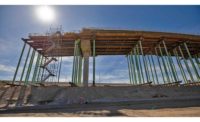 |
|
Changeover. Two-lane steel bridge will give way to four-lane segmental concrete model. (Photo courtesy of Tonia Jurbin) |
The two-lane, steel-truss Dollarton Bridge, built in 1948, will be replaced by October 2005 with a 200-ft-long, two-span reinforced c oncrete structure. Segmental precast concrete sections will support a deck overlay carrying four lanes for traffic, plus two 10-ft-wide sidewalks for cyclists and pedestrians.
The bridge spans the Seymour River just east of a Vancouver-area landmark, the Ironworkers Memorial Bridge, on the road to Deep Cove. It carries an average of more than 26,000 vehicles on weekdays.
|
Before tackling the superstructure, prime contractor Vancouver Pile Driving Ltd., North Vancouver, this summer fit in foundation work. The Seymour River, which spills into the Port of Vancouvers Burrard Inlet, is a prime habitat for pink salmon and steelhead. Both species lost 20 miles of habitat and 90% of their spawning grounds when the the city of Vancouver built Seymour Falls Dam to supply water. The salmons migratory cycle leaves only a 90-day window every two years when in-river work would not adversely affect the fish migration.
To protect the fish, the Dept. of Fisheries and Oceans Canada established a window from July 1 to Sept. 30 for the contractor to begin and complete work in the river, says Randy Sundher, project inspector for North Vancouvers Public Works Dept.
To drive 24-in.-dia steel piles, the contractor constructed a temporary trestle for a 100-ton crane with a boom that extends to 140-ft, says Sue Laforest, Vancouver Pile Driving project manager. After vibrating each pile section 18-25 ft deep, the contractor then employed a diesel hammer to sink the members to depths of 130-160 ft into granular alluvial fill, says Sundher. Each pile was in two sections that were welded together, he adds. Seven piles were in the river and another 14 were on land. The contractor removed the trestle in September after the last pile was sunk.
Laforest says overhead high-voltage lines imposed another challenge. "We couldnt have our crane boom within 10 ft of the wire," she says. Now that the foundation is in place, "we can start placing the segmental webs and dismantling the old bridge," Laforest says. She is confident the $3.4-million project will finish on schedule next year.
Canadian contractor scrambled to complete in-river work for a bridge replacement job near North Vancouver that had a tight window imposed by environmental regulations to protect migrating fish.


Post a comment to this article
Report Abusive Comment